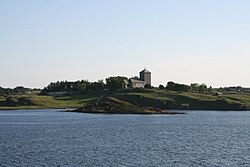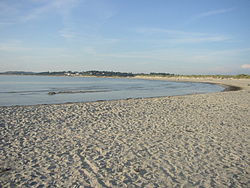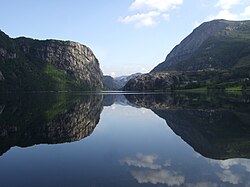Rogaland is a county in West Norway. Rogaland is a highly varied area from the sandy beaches and flatlands at Jæren, to the jaw-dropping cliffs of Lysefjorden, to charming lakes and fjord of Ryfylke and the barren uplands within.
Regions
[edit]- the North-Eastern corner of Rogland, includes islands, fjords, valleys and uplands around the inner part of the great Boknafjorden.
Towns
[edit]- 1 Bryne
- 2 Egersund Is the largest town in southern Rogaland.
- 3 Figgjo
- 4 Kleppe
- 5 Haugesund, approximately 2 hours from Stavanger and 3 hours from Bergen (in Hordaland).
- 6 Kopervik
- 7 Skudeneshavn - a small white-wooden town on the southern point of Karmøy island; protected by law since 2018.
- 8 Hellvik
- 9 Ogna
- 10 Sandnes
- 11 Sola - suburb of Stavanger and home to the airport as well as long sandy beaches
- 12 Stavanger, the largest town in Rogaland. Well known as an oil-town. Due to the oil, the town is very international. The town also has the newest university in Norway (founded in 2004).
Other destinations
[edit]- 1 Karmøy An island close to Haugesund. Karmøy means "the island that gives shelter from the open sea", known for the Vikings. It is this route that gave Norway its name ("the way to the north").
- 2 Orre
Understand
[edit]
Rogaland is the county on both sides of the wide Boknafjorden, as well as the valleys, uplands and smaller fjords to the east. The county consists of several distinct parts. Stavanger is the main city and sits on the northern end of the Jæren flatlands. Stavanger together with adjacent towns Sola, Sandnes and Randaberg is the third largest urban area in Norway with some 230,000 inhabitants (as of 2020), behind Bergen and Oslo. These towns are governed as independent municipalities and not officially regarded as one city but are often just referred to as Stavanger. Sandnes and Stavanger have practically merged and the city line is barely visible as the most densely built up area is the business district around the city line. Sola airport and suburb is halfway between Stavanger and Sandnes near the business district. Stavanger town itself covers a small area (about 50 square kilometers), the city of Bergen is 10 times wider.
Jæren is, by Norwegian standards, an unusual flatland and one of Norway's best agricultural districts. Jæren has wide sandy beaches (also unusual for Norway) and the Jæren coast is not fragmented by islands and fjords as the rest of Norway. Jæren is one of the few places in Norway that resembles Denmark. These flatlands are ideal locations for an airport and Stavanger airport at Sola opened in 1937 as the first civilian airport in Norway and one of the first in Europe with solid (concrete) runway. The airport was strategically important to German occupant during the second World War and was upgraded and expanded during the war. Since offshore oil was discovered off the Rogaland in the 1960s the airport has served the offshore facilities and the Stavanger area enjoyed a boom thanks to the oil business. South of Jæren is the district of Dalane (literally "the Valleys"), including Egersund and hinterland.
Islands in Boknafjorden and narrow fjord branches within belongs to the Ryfylke district. This inner area is very rugged and partly fragmented by fjords, lakes, gorges, cliffs and valleys. Lysefjorden with Pulpit rock is particularly famous. Pulpit rock is but one of many jaw dropping cliffs in around Rogaland's fjords and valleys. From Kjerag cliff waterfalls drop 1000 meters to the fjord (vertical drops may be around 700 meters making this one the tallest single drops in the world). At the same time there is relatively even upland/mountains known as Ryfylkeheiene above the deep valleys and fjords. Abundant rain on the uplands and steep terrain makes this area ideal for hydro power and the Ryfylke is home to the largest hydro power plant in Northern Europe.
North of Boknafjorden is the Haugalandet district. Haugalandet is peninsula fragmented by small fjords as well as Karmøy island connected to Haugesund by bridge. Haugesund is the town of Haugalandet and Haugesund airport is on Karmøy island.
Get in
[edit]
By plane
[edit]Stavanger airport (SVG IATA), is an international airport. Flights to Amsterdam, Bergen, Copenhagen, Kristiansand and Oslo. As well as other destinations. Haugesund airport (HAU IATA), has among other, scheduled flights to Oslo, Copenhagen (Summer only) and Gdansk.
By train
[edit]NSB operates trains from Oslo over Kristiansand to Stavanger. Eight hours.
By bus
[edit]Bus from Oslo to Haugesund, on Nor-Way busekpress[dead link]. Nine hours. There is also bus from Bergen to Haugesund and Stavanger.
By boat
[edit]West Norway can be reached by Fjordline ferry from Hirtshals in Denmark, to Stavanger and Bergen. There are also more frequent Color lines ferries from Hirtshals to Kristiansand, from where you can travel by car or train. Hirtshals is reached by DSB train.
By car
[edit]From Oslo to Stavanger, use E18. From Oslo to Haugesund, use E134. From Germany to Stavanger, take the car ferry from Hirtshals, as described above.
Get around
[edit]

By train
[edit]Local trains Stavanger-Sandnes and Stavanger-Egersund, operated by NSB.
By bus
[edit]Local buses, tickets and info by Kolumbus.
By car
[edit]At some places car ferries need to be used. They have a fee, usually of NOK 50-100. They go 1-2 times per hour and don't need booking.
See
[edit]
- The Lysefjord with the Kjeragbolten.
- Pulpit rock - Preikestolen.
- Jæren- A very "non-norwegian" area. A lot of people associate Norway with mountains and fjords; you'll find a very flat area called Jæren, south of Stavanger. Most of this area is Norway's most important farming land. Places like Bryne, Nærbø and Vigrestad are places you can visit here. In Nærbø you'll also find the museum Jærmuseet, which is based on the farming history in the area.
- Dalsnuten and few peaks around. Major hiking routes start from Gramstad.
- Melshei - hills and forest hiking. The main route has a light winter/night time
- Stokkalandsvatnet - beautiful hike around lake
- Møgedalsholen - hiking area along Figgjo river
- Hommersåk - a start point for many hiking routes in the area
- 1 Stone cross on Kvitsøy (Kvitsøy cross). 24. This cross is 4 meters high and 2 meters wide made from slate, erected on Kvitsøy island before year 1000. Exact age is unknown and was possibly made by English missionaries. The biggest of its kind in Norway. It is known from an historical event i year 1016. The cross is so big and prominent that sailors use it as a navigation point. free.
Do
[edit]Eat
[edit]
Rogaland specialities: Komla, smalaføtter (sheep's feet) and smalahove (sheep's head), pinnekjøtt (meat from lamb), lapskaus (a soup mostly found in Jæren).
Drink
[edit]Melkebaren
Megleren Øl & Vinstue Sandnes
Petite
Stay safe
[edit]Rogaland has a low crime rate. You should have no problems if you take the usual precautions. Main dangers are the narrow, bending roads and the sea.
Go next
[edit]
- Hordaland with Sunnhordland, Hardanger and Bergen
- Agder with Setesdal and Kristiansand
- Telemark
- Danmark via Hirtshals port

